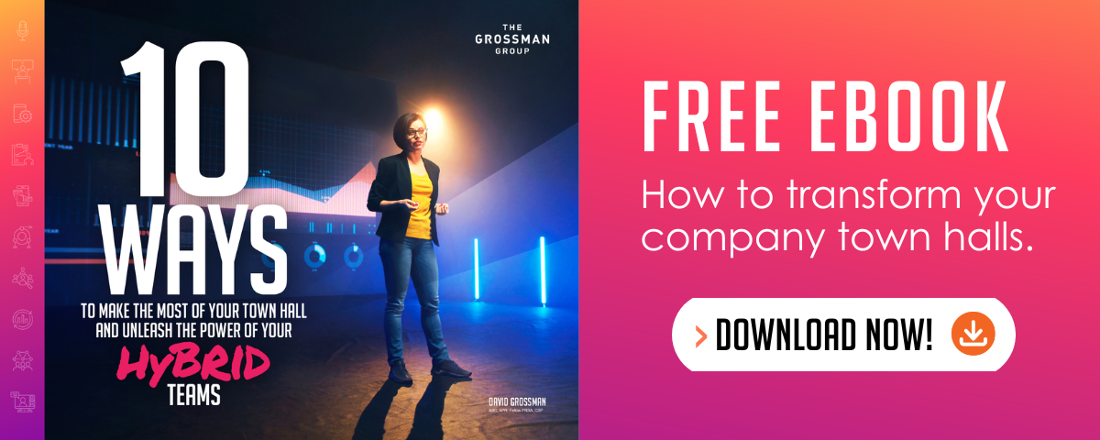What is a Company Town Hall Meeting? (+ How to Plan and Conduct One)

Think about the last “town hall” meeting you attended at your company. Was it something you and your colleagues looked forward to? Or, did seeing the time block on your calendar fill you with anxiety (over losing time in your day), annoyance (not wanting to sit through an excruciatingly boring meeting) or, worst of all, apathy (having no interest in attending knowing the content wouldn’t be relevant)?
Unfortunately, the latter is the case for many employees today.
While the concept of a town hall dates far back beyond our modern corporate world and these meetings played a crucial role in internal communications during the height of the pandemic, many employees still report that they can feel like a chore.
This is partly because employee needs and expectations are evolving in today’s “new reality”; in many cases, employees want to feel personally connected to their leaders, the company vision and values, and what the organization stands for.
There is a critical opportunity now for leaders and communications professionals to deliver far more informative, interactive and meaningful town halls that will engage employees.
Whether you are a seasoned planner or embarking on setting up your company’s first town hall meeting, we’ll explore in this blog post why town halls are important, the components of a successful town hall, steps you can take to plan one, a sample agenda and best practices to inform, engage and inspire your employees.
What is a Company Town Hall Meeting?
Town halls – also commonly referred to as “all-hands meetings” – are often the centerpiece of a company’s internal communications plan. They are leadership’s annual, quarterly or, sometimes more frequent, opportunity to talk with employees about business results, priorities, future plans and strategies, and to recognize individual or team achievements.
In the best cases, these sessions are interactive and inspiring, moving beyond the “talk at” and “command/control” formats to actually build an engaging, informative conversation with employees.
Why are Town Hall Meetings important for an organization?
Town hall meetings are unique from company to company and serve different roles for different leadership teams. Regardless of your company’s size, your industry or the challenges you might be facing, an effective town hall can be an important tool to aid with employee engagement, trust in leadership and sense of belonging – three pillars that are critical to retaining employees in today’s ultra-competitive labor market. Let’s break them down:
- Engagement: Engagement is an emotional connection employees have with their work, which in turn allows them to identify with, be motivated by and be willing to spend extra effort for their employer. Engaged employees are also often incredible advocates on behalf of a company and the brand.
Today, however, employee engagement levels are at an all-time low – the latest Gallup survey reports that employee engagement saw its first annual decline in a decade, dropping to just 32% in the first part of this year. - Trust: Trust is needed more than ever as companies move past the pandemic and establish their new reality. In today’s business environment, without trust, it’s impossible to have an effective hybrid or remote workforce, create a meaningful employee experience, engage and retain top talent, and more. Employees who trust their leaders will move mountains for them and be more engaged in the business.
- Sense of belonging: Belonging is a basic human need and one that translates to the work environment. Employees want to feel supported, included and part of something larger than themselves. The latest labor reports show that the “Great Resignation” isn’t slowing down, and employees are still leaving their jobs in droves. Fostering a sense of a belonging among your workforce can be the difference between an employee staying and leaving for their next opportunity.
Key Components of a Town Hall Meeting
So, how can you put together an effective town hall (whether it’s a virtual town hall meeting, hybrid or in-person) to help you engage your employees, enhance trust levels and foster a sense of belonging?
Here are the key components every town hall should include:
- Business update: Dedicate time to reviewing your company’s strategic goals and progress you have made against them or the challenges you might be facing. Help employees understand their role in advancing your business strategy and achieving key priorities. Various studies show that anywhere from 60% to 95% of employees don’t know their company’s strategy – it is the job of leaders to bridge this gap and drive performance. Remember to put the update in plain language to help employees see themselves in the strategy.
- Employee recognition: Set aside one portion of the agenda to focus on individual or team recognition. And don’t be worried if your company does not have a formal recognition program through HR to source names from – here are two ways you might implement a recognition segment at a town hall:
- Leader-driven: Say you conduct town halls quarterly and have 12 members on your senior leadership team. Ahead of each town hall, assign 3 leaders to recognize their teams. Provide them parameters to help them identify team members (i.e., this quarter we’re highlighting employees who live the company values or helped advance a specific priority). Honor team members’ recognition with a meaningful reward – such as lunch with the CEO – instead of a trophy or swag.
- Peer-driven: Put the recognition in the hands of employees and end your meeting on a high note. Call on one employee to recognize a peer for something they did, who will then name another peer, and so on. Each recognition recipient can receive a small gift card or other token. By making recognition a regular part of town halls, you’ll create a culture of gratitude and belonging.
- Q&A: An open forum for questions may just be the most important part of any town hall, but it isn’t always prioritized. Organizations often try to pack so much into one session that by the time all topics have been covered, employees’ eyes are glazed over and only ten minutes remain for Q&A.
A good rule of thumb is to allocate at least 30% of your meeting time to open discussions between employees and leaders. How you choose to field questions (e.g., live in the room, anonymously via a virtual meeting platform, in advance via email) should be determined based on several factors, including:- Location of your audience: Do you have employees attending live and virtually? You’ll need to incorporate technology that ensures remote employees have equal opportunity to submit their questions.
- Leadership comfort/skill level: How strong are your leaders as communicators? Do they need advance Q&A prep or can they answer off the cuff? If they are still building confidence as a communicator, implementing an approach that allows a member of the communications team to field questions through a platform and prompt the leader will help set them up for success.
- Watch out: Be careful not to screen all difficult questions – leaders need to be transparent and demonstrate vulnerability to earn trust from their workforce.
- The size of your audience: If you are speaking to a room with hundreds of employees, will everyone have a fair shot at asking a question or only those in the front row?
Town Hall Meeting Sample Agenda
The average town hall typically runs anywhere from 60 to 90 minutes – shorter than that and you’ll lose valuable open discussion time, longer than that you risk losing employee attention (this especially goes for virtual town hall meetings, where distractions are easily accessible).
Building on the three key components above, what might a town hall agenda template look like?
|
Time |
Topic |
Speaker |
|
3 min |
Welcome |
CEO |
|
10 min |
Business update |
C-suite member(s) |
|
15 min |
Timely topic |
Subject matter experts |
|
15 min |
Recognition segment |
Designated leaders or employee peers |
|
30 min |
Q&A |
Leadership team |
|
3 min |
Closing |
CEO |
Town Hall Meeting Planning Checklist
Now that you have a sample outline to build from for your next town hall meeting, what are the necessary steps you need to take to align on your agenda, gather your content and ensure it goes off without a hitch?
Schedule your town hall cadence at the beginning of the year; ensure calendar invites are on leaders’ calendars as early as possible to avoid future scheduling conflicts
Conduct an initial planning session between the CEO/President (or your top leader) and the communications team to align on the agenda for the town hall (2-3 weeks prior)
Reach out to speakers and subject matter experts to gather content/slide visuals (1-2 weeks prior)
Build out the slide deck and work with design services (if available) to create a cohesive presentation (3-4 days prior)
Draft the anticipated Q&A document and circulate it with leaders who will be responsible for fielding questions (3-4 days prior)
Conduct a rehearsal with all speakers (1-2 days prior)
Conduct the final tech check and discuss any last-minute questions from speakers (morning of)
Scenario Planning
In today’s business environment, town halls are taking on different shapes and formats, and constantly evolving to adapt to the shifting workforce composition. What are some common scenarios you can expect to encounter in planning your town hall, whether it’s a virtual town hall, in-person, or hybrid, and how can you prepare for them?
Hybrid Attendees:
Gone are the days of an entire organization gathering in-person at a single location for a company town hall. A growing number of companies, including 3M, Zillow and Twitter, have introduced policies to allow the majority of their employees to work from home permanently, even after the pandemic.
Companies that are “remote first,” have a hybrid workforce or even different office locations need to prioritize finding an advanced technology solution that will support the needs of their town hall.
Even if your company defaulted to one platform during the pandemic, ask yourself if it’s meeting your communications needs today:
- Is there an attendee cap or time limit for sessions?
- Can users submit questions and chat?
- Is this a user-friendly experience for employees?
- How is audio and video buffering?
- Can the meeting be recorded?
- Does it offer closed captioning or live translated captions?
Regularly assess your workforce and your communication needs, and ensure you are using the platform that is best for your company.
Employees Across Shifts and Time Zones:
If a portion of your workforce is not on shift during the town hall or cannot leave their workstation to attend or works from a different time zone, it is important to make the content available to them at a time they can access it.
To do so, leaders could host the town hall more than once (e.g., one morning and one evening session) or you can record the town hall and send a replay link along with a written recap note to all employees.
Still, it is difficult to ensure that every single employee will be able to attend the meeting or watch the replay. Thus, it is important to set expectations with leaders on what they need to communicate to their teams and provide them with the necessary support to cascade the information accordingly (e.g., messaging points, leader toolkits, presentation slides).
Tips to Take Your Town Hall to the Next Level
With your agenda, planning checklist and meeting technology in place, what other factors might you consider to transform your town hall from that dreaded monthly meeting to a must-attend event? Consider the following ideas:
- Incorporate audience response technology to engage your audience. Use in-meeting polling to invite employees (in the room and globally) to share real-time impressions of a big agenda item. Invite responses to questions and have those responses show up on the screen as word clouds or other formats. Input could be prompted with a few questions during the session – for example: What excites you most about this big idea? What will you tell your family/friends about this idea?
- Share the stage. Don’t let your town hall become the CEO show. Build trust in your entire leadership team by inviting leaders across the organization to deliver relevant updates based on the agenda. And then don’t stop there. Employees want to hear and learn from their peers. Instead of having a senior leader deliver an update or a case study, consider having them facilitate a panel discussion with the employees who worked on the project.
- Change it up. While consistency can be key, if you are a company that has frequent town halls (say, every month), don’t be afraid to do one a little differently. Give the business updates a break and instead create an agenda that is solely focused on inspiring your employees.
Bring the outside in – your customers, your patients, an inspirational speaker, etc. – who can energize, motivate and thank employees for everything they are doing to advance your company’s work. Taking a step back to reflect and reconnect to one another and the company’s mission will breathe new energy into the organization – read on to the following case study to see how we worked with one of our clients to do just so.
Town Hall Meeting Case Study: How One Organization Raised the Bar to Inspire
Beyond the Standard Town Hall: “A Dose of Inspiration”
Employees at a leading pharmaceutical company were change-weary from the volume and intensity of change over the past two years and, coupled with pandemic frustrations, feelings of uncertainty and anxiety were rising. We partnered with the communications team to create a reset moment for the organization called “A Dose of Inspiration,” during which the team came together to:
- Pause to acknowledge the changes and challenges
- Recognize and celebrate associates and milestones
- Re-center on their critical mission – transforming the lives of patients and their families
- Inspire associates about the future and their role in the company’s success
The event was not another town hall – the content was inspirationally toned and high level, versus focused on business updates. It featured both internal and external speakers who helped associates take stock of how they can find inspiration from their patients, one another and within.
Now in its second year, employees have called A Dose of Inspiration “the best [company] meeting to date” and “absolutely inspiring from start to finish.”
- 78% reported feeling more connected to the company’s mission
- 80% said they were “completely” inspired
Conclusion
With thoughtful planning and careful execution, town halls are an incredible internal communications platform to engage your workforce and make a real, lasting impact on your company’s business goals. But, we know that implementing a new way of communicating – whether it’s introducing town halls altogether or shifting how they’ve always been done – can be daunting.
You might be asking yourself, where do I start or how will I get buy-in from leadership on this approach?
We can help! We partner with organizations of all sizes to transform how they communicate internally and reach and engage employees through effective town halls. We love putting our experience to use as we partner with communications teams to make the workplace better, and help leaders show up in an authentic way. If you’d like help, reach out. We’d be delighted to partner.
We also have a new eBook, 10 Ways to Make the Most of Your Town Hall and Unleash the Power of your Hybrid Teams, that’s designed to help get you started.
Download your free copy here.
How will transforming your town halls into must-attend events help you drive employee engagement and your desired business outcomes?
—Jennifer Hirsch
 Jennifer Hirsch is Vice President at The Grossman Group and brings strategic communications experience, a problem-solving mindset and zealous quality control to help clients achieve their business and communications goals. She has collaborated with Fortune 500 clients across the pharmaceutical, hospitality, technology, energy, manufacturing and CPG industries to deliver internal communications solutions and counsel that help companies perform from the inside-out. Connect with Jennifer on LinkedIn here.
Jennifer Hirsch is Vice President at The Grossman Group and brings strategic communications experience, a problem-solving mindset and zealous quality control to help clients achieve their business and communications goals. She has collaborated with Fortune 500 clients across the pharmaceutical, hospitality, technology, energy, manufacturing and CPG industries to deliver internal communications solutions and counsel that help companies perform from the inside-out. Connect with Jennifer on LinkedIn here.



Comments on this post